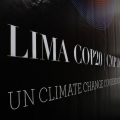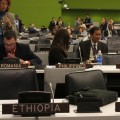As delegates in Geneva this week to dive into the nitty-gritty of the Paris agreement—the new global climate deal to be agreed in France’s capital at the end of the year—The Verb reflects on the ‘need to knows’ and lessons from the Lima Call for Climate Action, and what they presage about climate politics in 2015.
Spoiler: it’s mostly bad.
- The Paris agreement will reflect the ‘principle of common but differentiated responsibilities and respective capabilities, in light of different national circumstances‘.
First up, we have a possible legal change. In Lima, the legal principle of Common but Differentiated Responsibilities and Respective Capabilities (CBDR-RC) underwent an important transformation.
CBDR-RC has been a mainstay of the international climate regime since its inception. It divides the world into developed countries, which would lead the way on climate action; and developing countries, which would have far fewer restrictions and responsibilities.
But the world has changed considerably since the concept of CBDR-RC was first introduced in the early 1990s, and some developing countries are now among the world’s biggest emitters. Think China, India and Brazil.
Developed countries in Lima refused to allow reference to the CBDR-RC principle in the context of the Paris agreement without acknowledging these changed global realities. Conversely, developing countries were adamant they could not go along with a text that did not recognise the central importance of the principle.
A compromise was introduced in the final hours of the Lima negotiations when countries agreed on the phrase ‘common but differentiated responsibilities and respective capabilities, in light of different national circumstances.’ This marks the first time that developing countries have accepted a qualification of the principle.
This wording is taken directly from the US-China Joint Announcement on Climate Change made in November 2014. Considered acceptable by the two most powerful players in the international climate negotiations, and having now found its way into official United Nations language, there is a strong likelihood that similar language will make it into the Paris agreement.
Although it’s too early to tell how this new phrasing will be implemented under the new climate regime—chances are that different countries have chosen to interpret it in different ways—for the first time in 25 years, it creates room for a more nuanced division of responsibilities than the dated and rigid dividing lines of the past.
- The Paris agreement ‘shall address in a balanced manner inter alia, mitigation, adaptation, finance, technology development and transfer, and capacity-building and transparency of action and support’—but what about loss and damage?
What was left out of the Lima text is as important as what was included.
Developed countries are pushing for a new agreement in Paris that focuses principally on the reduction of global greenhouse gas emissions.
They want to see much deeper cuts coming from certain developing countries and emerging economies, which is also in line with what science says is necessary to keep global warming to tolerable levels, as the Structured Expert Dialogue meetings in Geneva also recently concluded.
But many developing countries are already feeling the effects of global warming and are rightly sceptical about the world’s ability to manage it. They generally have far less responsibility for historic greenhouse gas emissions, less capacity to undertake climate action, and are concerned that making emissions cuts will impinge on their development pathways.
They are fighting hard for a new agreement that gives adequate weight to adaptation, financing, technology transfer and capacity building.
Paragraph two of the Lima Call generally appears to balance these different concerns. Yet in what emerged as one of the key fights of the Lima talks, an earlier version of the same paragraph also saw the concept of loss and damage singled out as a key element of the Paris agreement.
Loss and damage reflects the idea of compensation for climatic events countries cannot adapt to, such as sea level rise. It is a priority for many poor countries and small island states.
But the costs of climate change-related loss and damage are devilishly difficult to calculate, and could potentially soar to billions of dollars. In Lima, rich countries pushed successfully for the term to be excluded. They prefer to see discussions on this topic relegated to a separate mechanism put into place in Warsaw in 2013.
As a result, reference to loss and damage is now only made in the preamble of the Lima text, where it carries less legal weight.
Nevertheless, the fight is not over. As highlighted by the world’s Least Developed Countries in a reaction to the Lima text, mention of loss and damage in the Lima text’s preamble and the use of the term ‘inter alia’ (a Latin term for ‘among other things’) when describing the scope of the Paris agreement, leaves the door ajar to a deal in Paris that does address this concern. Developing countries in Geneva are already gearing up for the second round of this battle, with many calling for a dedicated section for loss and damage in the Paris agreement’s draft elements text currently under discussion.
- When countries communicate their intended greenhouse gas mitigation efforts next year, they ‘may’ share various types of information meant to facilitate the clarity, transparency, and understanding of their commitments—but they’re not obliged to.
One of the key required outcomes of the Lima talks was for countries to come up with information requirements to accompany their intended nationally determined contributions (INDCs). These are the efforts countries are willing to make in the context of climate action, which they will all announce over the course of next year.
As a result, the Lima text calls for countries to share ‘quantifiable information on the reference point’, ‘time frames and/or periods for implementation’, ‘scope and coverage’, and ‘assumptions and methodological approaches’ of their INDCs. Whether countries choose to do any of this, however, is ultimately still up to them.
After interventions from some of the more hard-line developing countries concerned about having to make drastic emissions cuts, the Lima text was watered down to mandate that countries ‘may include’ such information.
This discretionary language could potentially be very problematic for the comparability and transparency of parties’ INDCs and make it difficult for them to be properly scrutinised. On the other hand, political pressure may see certain governments limit their weasel words, even if the legal language does not.
- Despite the strong scientific case for review, top-down assessment of parties’ intended efforts will be limited.
As previously reported by The Verb, if countries are serious about addressing climate change, it will be necessary to subject their intended mitigation actions to a stringent review.
In Lima, various countries pushed hard for some sort of assessment and ‘dialogue’ to examine and discuss intended contributions in light of their mitigation adequacy.
Some want an international review of the fairness of contributions instead of giving each country free licence to do what they want.
But despite an earlier version of the Lima text attempting to placate countries with the prospect of a dialogue that was ‘non-intrusive and facilitative’ and ‘respectful of national sovereignty’, such international scrutiny still went too far for certain hard-line developing countries.
As decided in the final Lima text, no multilateral dialogue will take place on the intended contributions. Instead, INDCs will be published online, and the Secretariat of the UN Convention on Climate Change, UNFCCC, will prepare a synthesis report on their aggregate effect by 1 November 2015.
Sources tell The Verb that it was a considerable struggle in the last hours of negotiations to even get agreement for such a report.
It’s better than nothing, but the planned publication date of 1 November 2015 will be far too late, and is unlikely to compel governments to significantly enhance their contributions just a month before the Paris negotiations commence. Civil society offers a glimmer of hope: there are signals that the NGO community will take matters into its own hands by organising a robust review of INDCs halfway through this year.
- More of the same really isn’t going to cut it
Lima saw wins and losses for climate mitigation and vulnerable communities, and resulted in a compromise widely described as “a mixed bag”.
A half-hearted approach will hardly be sufficient for staving off climate change, however.
Countries have an opportunity to redress some of the damage done in Lima as they commence negotiations on the Paris agreement’s substance in Geneva, and bridges can also be built at the three other formal negotiating sessions planned before December.
So far, though, a lacklustre outcome seems to be on the cards for the rest of the year: last week saw top UN and EU officials temper expectations for the new climate agreement. Aggregate emissions reduction pledges are widely expected to be inadequate for staving off harmful climate change.
Going against appearances to the contrary, president of the Lima negotiations, Manuel Pulgar-Vidal, warned delegates in Geneva on Sunday that “the world is not willing to accept failure”.













comment